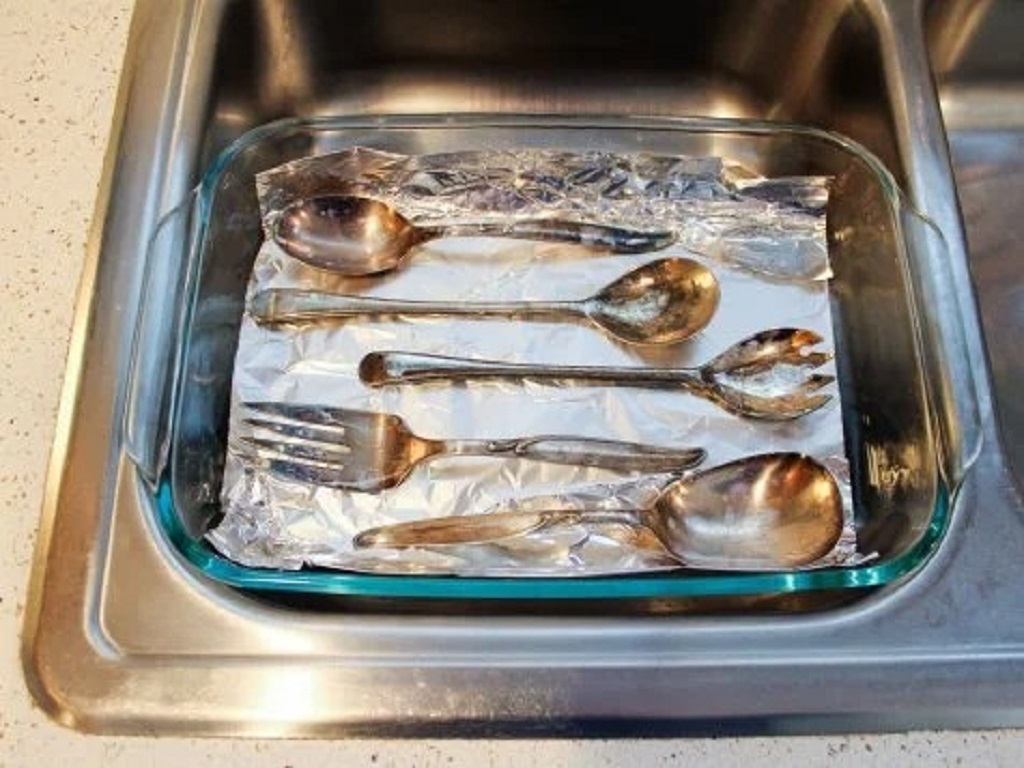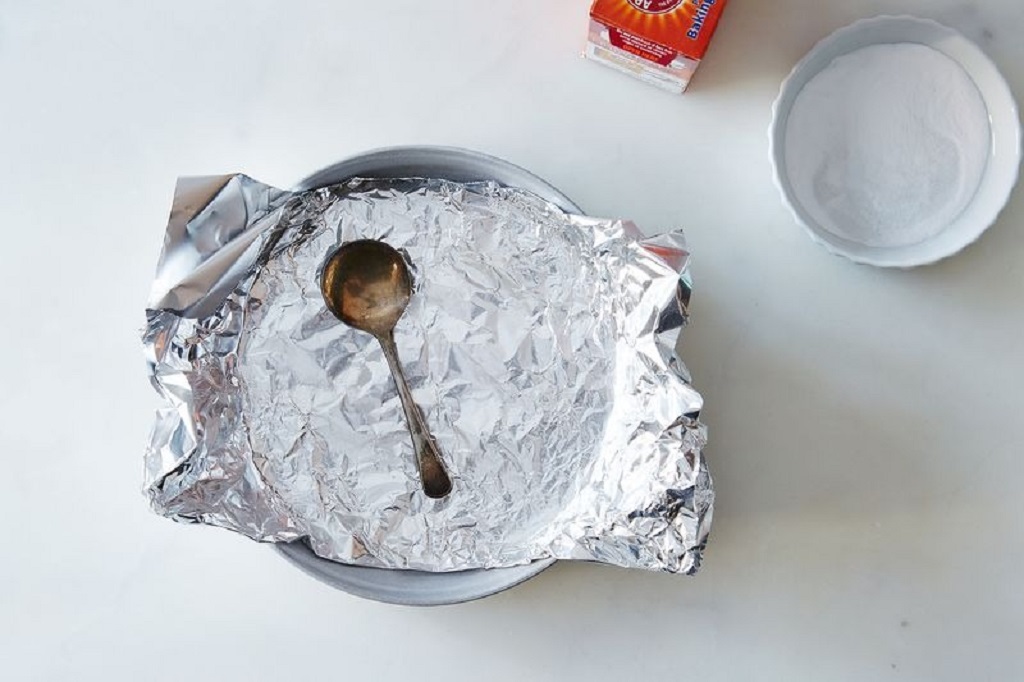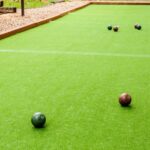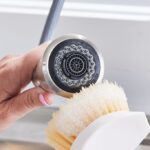
In this guide, we’ll walk you through a step-by-step process to clean silver cutlery with tin foil, restoring your pieces to their original luster in a way that’s gentle on the metal and safe for you and the environment.

Table of Contents
ToggleWhy Does Silver Tarnish?
Before jumping into the cleaning process, it helps to understand why silver tarnishes in the first place. When silver comes into contact with sulfur compounds in the air, it undergoes a chemical reaction, forming silver sulfide. This compound creates the dark layer that we recognize as tarnish. The more exposure silver has to air, humidity, and certain foods (like eggs and onions), the more likely it is to tarnish over time.
Traditional silver polishes can be abrasive, potentially wearing down the surface of the silver with frequent use. That’s why a non-abrasive solution, like tin foil and baking soda, is a fantastic choice for maintaining the integrity of your silverware while removing tarnish effectively.
Read More Also: The Essential Guide to Dock Ladders
What You’ll Need
For this method, gather the following items:
- Aluminum tin foil (enough to cover the bottom of your sink or a container)
- Baking soda (about one tablespoon for each cup of water used)
- Hot water (enough to submerge the cutlery)
- A large container or sink
- A soft cloth for drying
This method works because of a chemical reaction between the silver sulfide (tarnish) on your silver and the aluminum in the tin foil, facilitated by the baking soda and hot water. This reaction breaks down the tarnish and allows it to be transferred onto the aluminum foil, leaving your silverware bright and clean.
Step 1: Prepare the Cleaning Area
To begin, line your sink or a large container with tin foil. Place the shiny side up as it’s best for attracting tarnish to the foil. Lining your container with tin foil helps create an optimal environment for the chemical reaction to take place, ensuring your silverware gets thoroughly cleaned.
If you prefer not to use your sink, choose a container large enough to fully submerge your silver cutlery.
Step 2: Add Baking Soda and Hot Water
Pour hot water into the lined container or sink, adding one tablespoon of baking soda for each cup of water. The water should be hot enough to dissolve the baking soda quickly but not boiling, as boiling water can cause certain silver items, especially those with glued handles or decorations, to separate or get damaged.
The baking soda acts as a catalyst for the chemical reaction, helping to break down the tarnish more effectively. Stir the water gently to dissolve the baking soda completely.
Step 3: Submerge the Silver Cutlery
Place your tarnished silver cutlery directly onto the tin foil in the baking soda solution. Ensure that each piece has contact with both the foil and the baking soda-infused water. The reaction needs a connection between the silver and the tin foil to work effectively, so you may need to shift pieces around to achieve this.
Allow the cutlery to soak for a few minutes. You may start noticing that the tarnish appears to “lift” off the silver and onto the foil, sometimes with slight bubbling or a faint odor as the sulfur compounds are neutralized.
Step 4: Check and Rotate if Necessary
After a few minutes, check the progress. Heavier tarnish may require a longer soaking time, and you may need to rotate or flip pieces to ensure all sides have adequate contact with the foil and solution.
Typically, light to moderate tarnish will disappear within five to ten minutes, while heavier tarnish may take closer to 15 minutes. Avoid leaving the silver in the solution for too long, as the reaction slows down once the tarnish is removed, and extended soaking won’t necessarily improve the results.
Step 5: Rinse and Dry Thoroughly
Once the tarnish has lifted, remove the cutlery from the solution and rinse each piece under warm running water. This rinse will clear away any remaining baking soda residue and prevent it from drying on the silver surface, which could create a dull film.
Dry each piece thoroughly with a soft, lint-free cloth. Buffing the silver as you dry can also help bring out its shine. A microfiber or cotton cloth works well for this purpose, as these fabrics won’t scratch or dull the surface of the silver.
Additional Tips for Maintaining Silver Cutlery
Now that your silver cutlery is sparkling, here are some tips to help keep it looking that way longer:
- Store Properly: Wrap silver cutlery in anti-tarnish cloths or store it in tarnish-resistant bags. Avoid wrapping it in plastic, as this can trap moisture, which accelerates tarnishing.
- Avoid Contact with Certain Foods: Foods containing sulfur, like eggs and onions, can speed up tarnishing. If you use silverware with these foods, wash and dry it immediately afterward.
- Hand Wash Only: Avoid putting silver cutlery in the dishwasher, as the heat, moisture, and detergents can lead to discoloration and tarnish. Always wash silver by hand with mild soap and dry it immediately.
- Polish Occasionally: Even with regular care, silver may occasionally need a light polish. Use a non-abrasive silver polish or cloth to maintain its shine.
Why This Method Works
The tin foil and baking soda method is effective due to a process called electrolytic reduction. When silver sulfide (tarnish) on the cutlery comes into contact with the aluminum in the presence of baking soda and hot water, it undergoes a chemical reaction that breaks down the tarnish and transfers the sulfur from the silver to the foil. This process leaves the silver’s surface undamaged, unlike some harsh polishes which can wear down the metal over time.
When to Use Caution
While the tin foil and baking soda method is generally safe, there are a few cases where you might want to avoid it:
- Antique or Heavily Decorated Silver: If your cutlery is very old or has intricate designs, consider using a professional cleaning service or testing a small area first, as certain details could be sensitive to the process.
- Silver Plating: This method can be harsh on silver-plated items if used frequently, as repeated chemical reactions may erode the thin layer of silver over time.
Final Thoughts
Keeping silver cutlery in top condition doesn’t have to be a chore or require expensive cleaners. Using simple tin foil, baking soda, and hot water can yield professional-quality results without the chemicals or abrasion. Not only is this method gentle on silver, but it’s also cost-effective and environmentally friendly, making it a perfect choice for anyone looking to maintain their silverware’s timeless beauty.
With the right care and storage, your silver cutlery can stay sparkling for years, ready to impress at every meal and cherished for generations to come.






